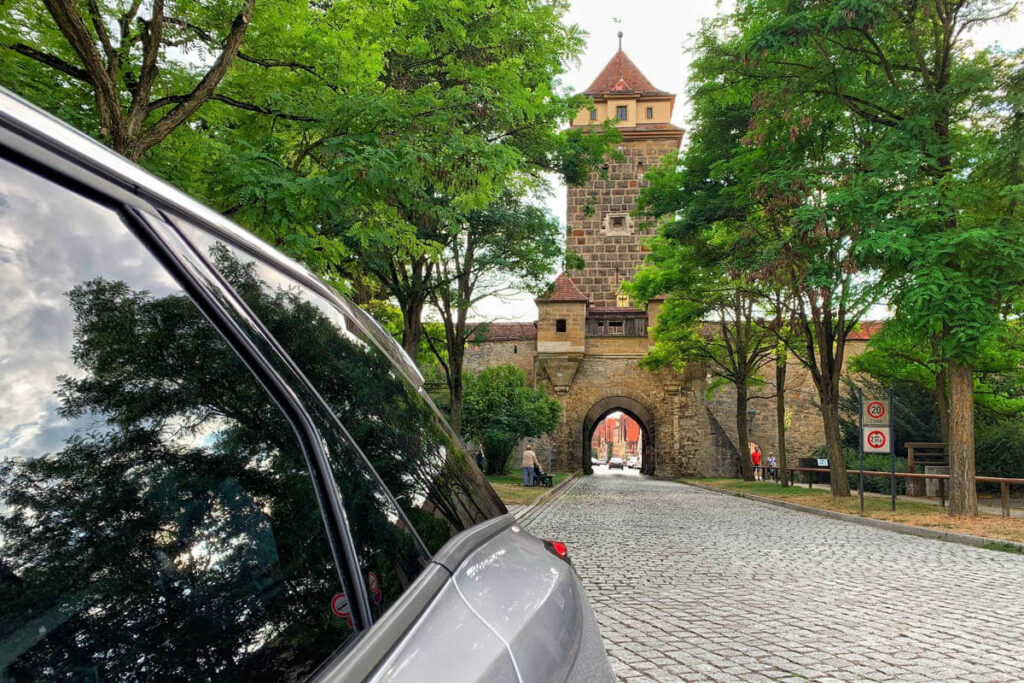Ever heard of the Romantische Straße in Germany (Romantic Road)? It’s a route that winds through beautiful landscapes and past charming towns in Bavaria, southern Germany. Rothenburg ob der Tauber is one of the towns along this famous tourist route, attracting visitors from all over the world who come to experience its medieval atmosphere. In this article, you’ll find 15 highlights and sights to see in Rothenburg ob der Tauber.
Romantische Straße (Romantic Road) in Bavaria
The Romantic Road (Romantische Straße) starts in Würzburg and stretches to Füssen, covering a distance of 460 kilometers. Along the route are 29 notable destinations, each offering something special; castles, country houses, medieval villages, wine estates, art, culture and more. At the end of the Romantic Road is the famous Neuschwanstein Castle, a major highlight to look forward to during the journey. This route isn’t just for cars; cyclists and hikers can also enjoy the journey, thanks to designated bike and hiking trails.
Rothenburg ob der Tauber
One of the most popular towns along the route is Rothenburg ob der Tauber. As its name suggests, the town is located along the Tauber River. Founded around 1000 AD by a noble lord, visiting Rothenburg feels like stepping back in time. It’s almost as if time has stood still. After the Thirty Years’ War (1618-1648), the town fell into a kind of deep sleep and development virtually halted. This may explain why so much from that era has been preserved.
Though an American air raid in 1945 nearly reduced half of Rothenburg to ashes, the medieval center was spared much of the destruction. Today, you can still see the intact town wall with dozens of gates and towers. Additionally, Rothenburg’s center is filled with monumental buildings.
15 highlights in Rothenburg ob der Tauber
As we make our way to Austria for a road trip through Tyrol, we visit several places in Bavaria, including Rothenburg ob der Tauber. We had read that it’s a very touristy spot and planned to just take a quick look around. However, our visit turns out to be much longer than expected. We spend nearly a whole day in Rothenburg because there’s so much more to see than we imagined. And while we don’t manage to see everything, we explore enough to compile a list of 15 sights in Rothenburg ob der Tauber.
Medieval city wall (Stadtmauer)
When Rothenburg was granted city rights in 1172, the construction of the small inner city wall began. This wall includes landmarks such as the Markusturm and the Weißer Turm. The outer city wall, which stretches for almost 3.5 kilometers, was built at the end of the 14th century. Several additional fortified entrance gates, like the Galgentor and Kobolzeller Turm, feature towers on top. Here, you can clearly see the double walls, with multiple gates positioned one behind the other. Just a small section of Rothenburg is not protected by the city wall. This area was once a large swamp, providing a natural barrier centuries ago.
In 1945, much of the city, including parts of the city wall, was destroyed. After the war, the United States made a generous donation to help rebuild the damaged sections. This contribution is commemorated with donor plaques incorporated into the city wall at various points. From the city wall, you can enjoy a beautiful view of the town. On the outskirts, it’s incredibly quiet and in most places, you won’t see another person. “What do you mean, touristy?” was our first reaction. It turns out that the highest concentration of tourists is around the Marktplatz. In the little streets behind the square, it’s peaceful once again.
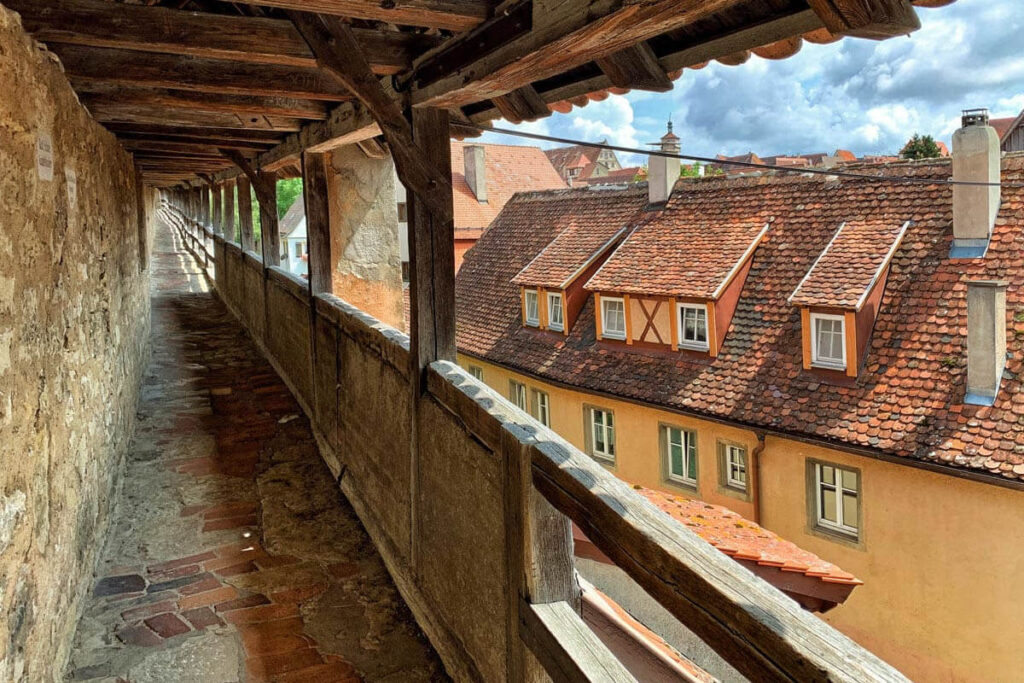
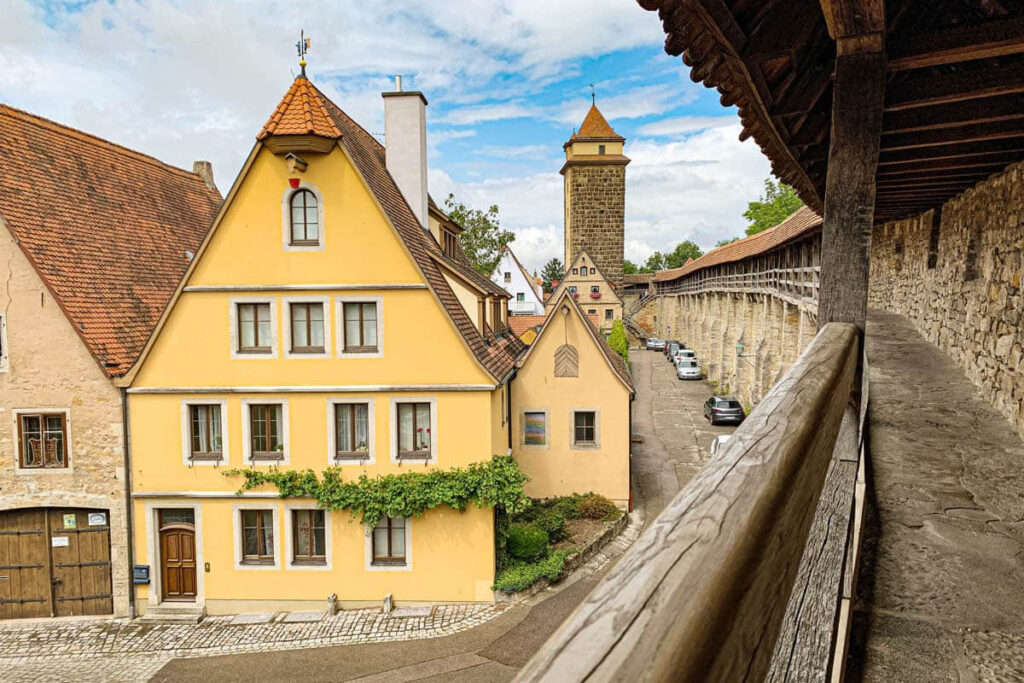
Klingentor
The Klingentor served several functions in the past. Naturally, the gate beneath the tower provided access to the city and defenders could easily shoot at intruders from above. Additionally, the Klingentor was one of the key points in town where a fountain was located. Residents of Rothenburg would fetch their water here, making it a social meeting place as well.
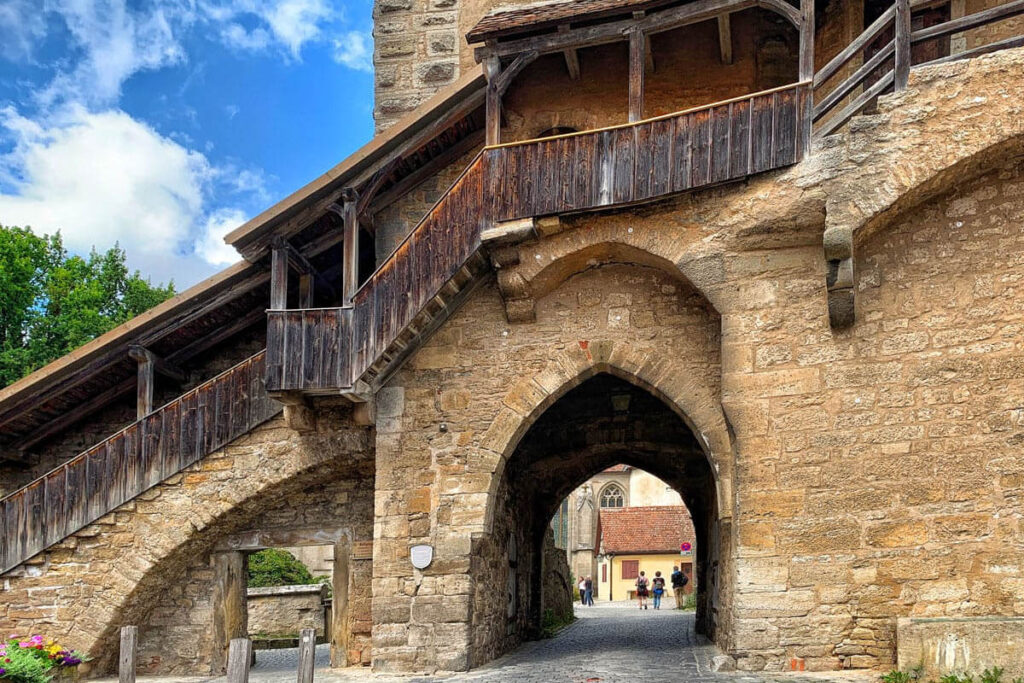
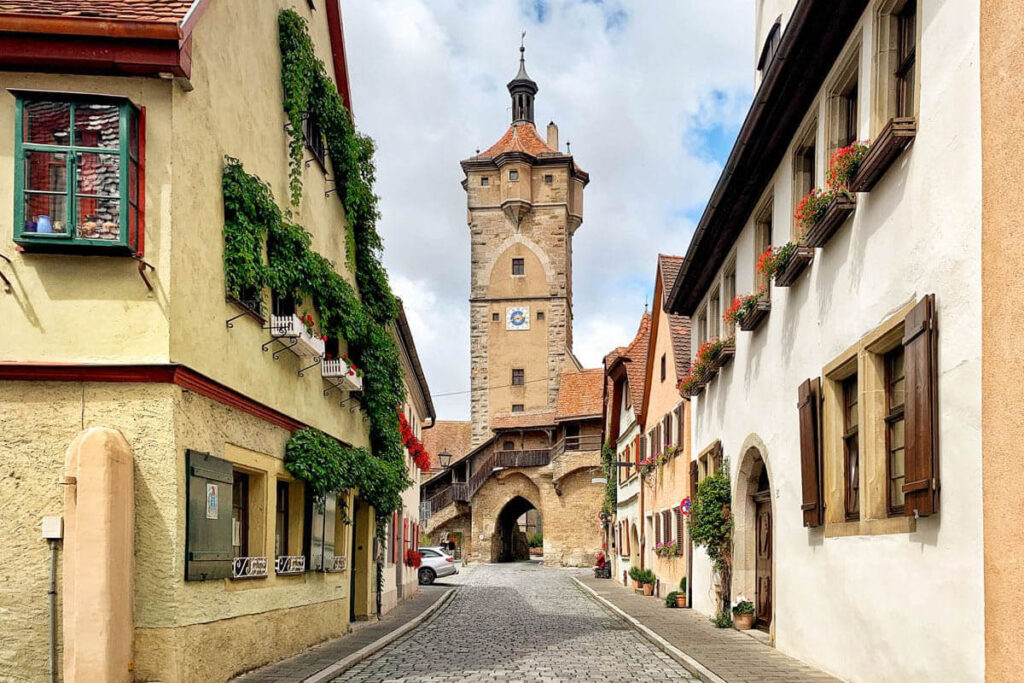
Klingentorbastei / St. Wolfgangskirche
Walk under the Klingentor and you’ll reach the St. Wolfgangskirche, also known as the Schäferskirche. St. Wolfgangskirche is connected by a wall to the Klingentor, making it part of Rothenburg’s fortifications. The church was built at the end of the 15th century on the site where shepherds once gathered to worship St. Wolfgang. From outside the town wall, the church doesn’t look like a typical place of worship. With its thick walls, it resembles more of a fortress. Inside, you’ll find three altars dating from the late 15th and early 16th centuries. The church earned the nickname Schäferskirche during the time when the Schäfer fraternity held weekly services here.

Plönlein
Plönlein is probably the most photographed spot in Rothenburg ob der Tauber and is often featured on Instagram. It has appeared several times in “most Instagrammable places” lists. The name Plönlein comes from the Latin word planum, meaning flat square. This picturesque location truly captures the imagination, with its unique street level differences, the charming half-timbered house with a fountain in front and the two towers (Siebersturm and Kobolzeller Tor) in the background. It’s hard not to find this place both charming and photogenic!
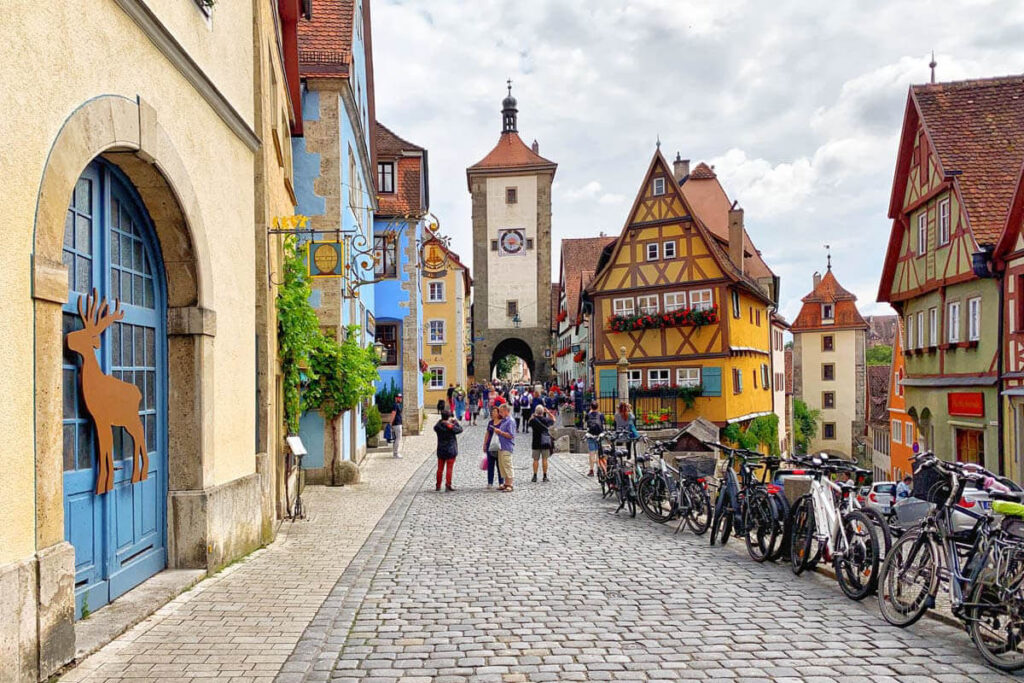
Siebersturm
Walk across Plön Square and you’ll pass under the Siebersturm. This tower was built in 1204 during the city’s initial expansion. It was used until the 14th century to protect the southern gate. While the side of the Siebersturm facing Plönlein is probably more famous, the opposite side is equally beautiful. Once again, charming half-timbered houses line both sides of Spitalgasse.
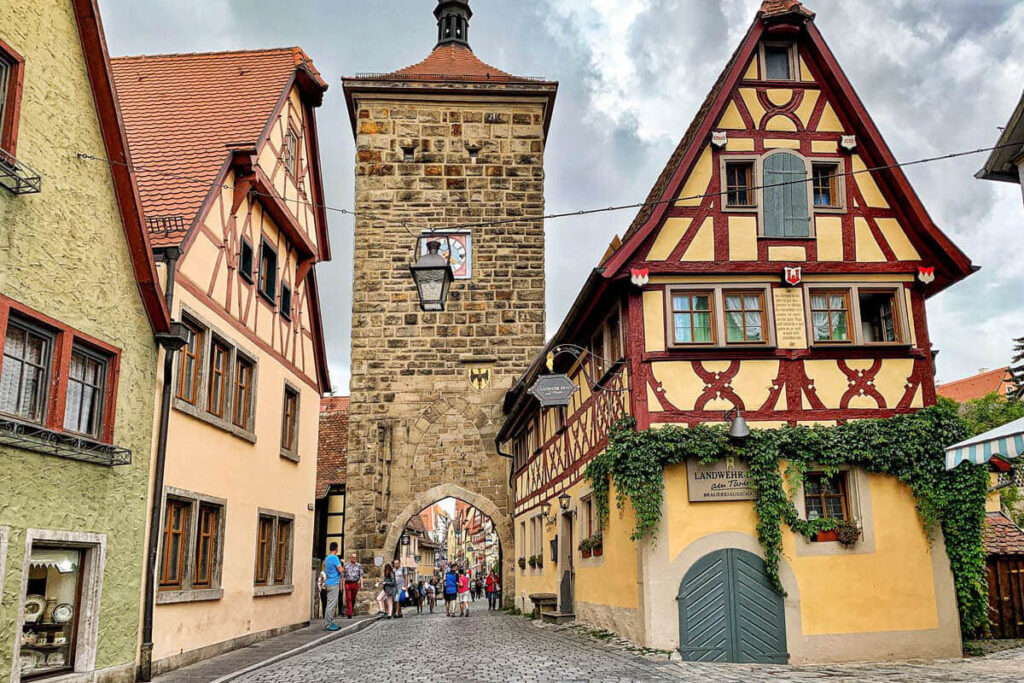
Kobolzeller turm and Kobolzeller Steige
The Kobolzeller Turm is located just beyond the Siebersturm and, in my opinion, is one of the most impressive spots in Rothenburg. Here, you can truly appreciate the effort it took to protect a town in the Middle Ages. A series of gates lined up in succession provided strong protection at the town’s entrance from the Tauber Valley. Between the gates, you’ll find the Kobolzeller Steige, a pathway that leads toward the Kobolzeller Tor. It’s a beautiful part of Rothenburg ob der Tauber, where you can truly feel like you’ve stepped back in time.
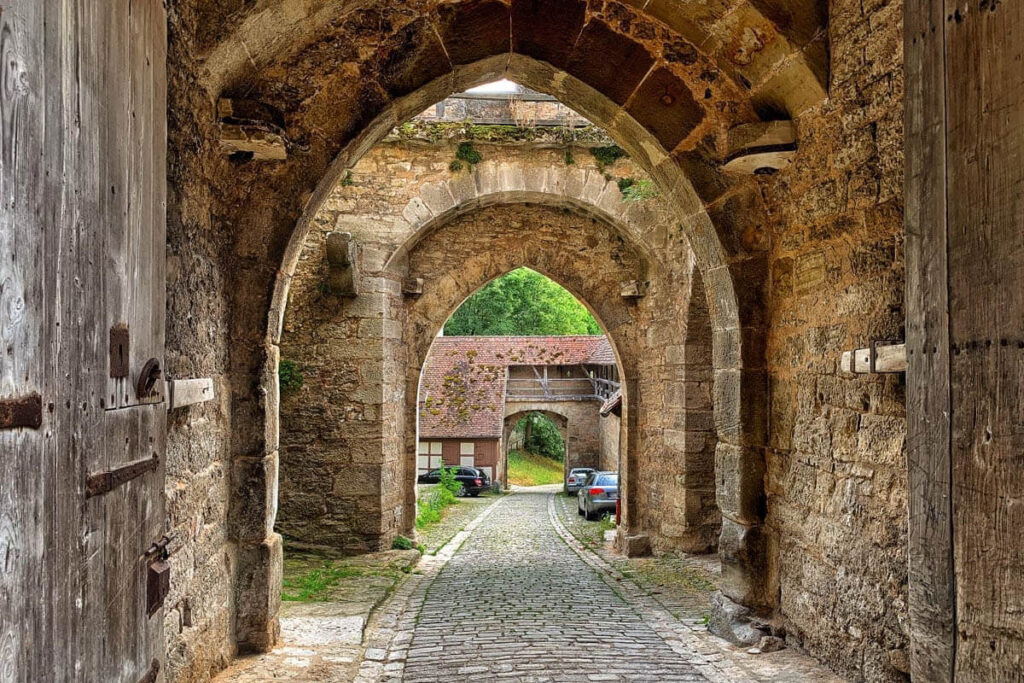

St.Jakobskirche
In the mid-15th century, the magnificent St. Jakobskirche was built. Inside, you’ll find several impressive altars, including the famous Heiligblutaltar. This carving, created in the early 15th century, depicts the Last Supper. The beautiful stained glass windows in the church are over 700 years old. The church also features a gateway, similar to the one at St. Wolfgangskirche. Rothenburg ob der Tauber certainly doesn’t lack gates!
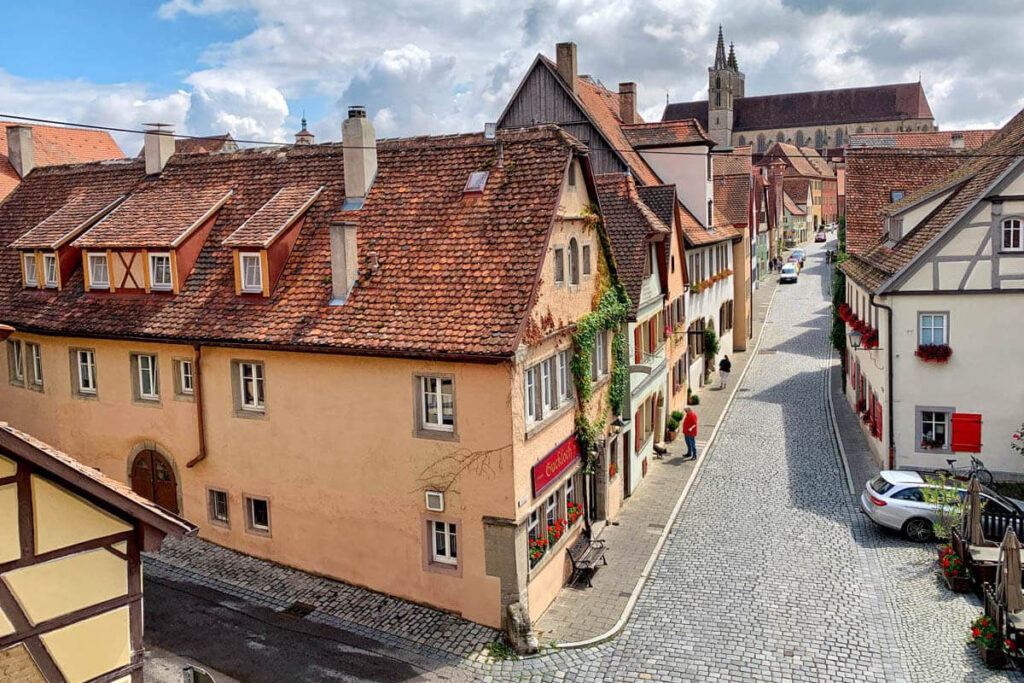
Markusturm u. Röderbogen
The Markusturm and Röderbogen were also built as part of the first city wall in the early 13th century. At that time, there were three other official watchtowers. This was quite different from a few centuries later, when the outer city wall was completed, with as many as 70 towers used for keeping watch. The building on the right of the photo was originally the toll house in the Middle Ages. Today, it houses the Romantik Hotel Markusturm, one of the best hotels in Rothenburg ob der Tauber.
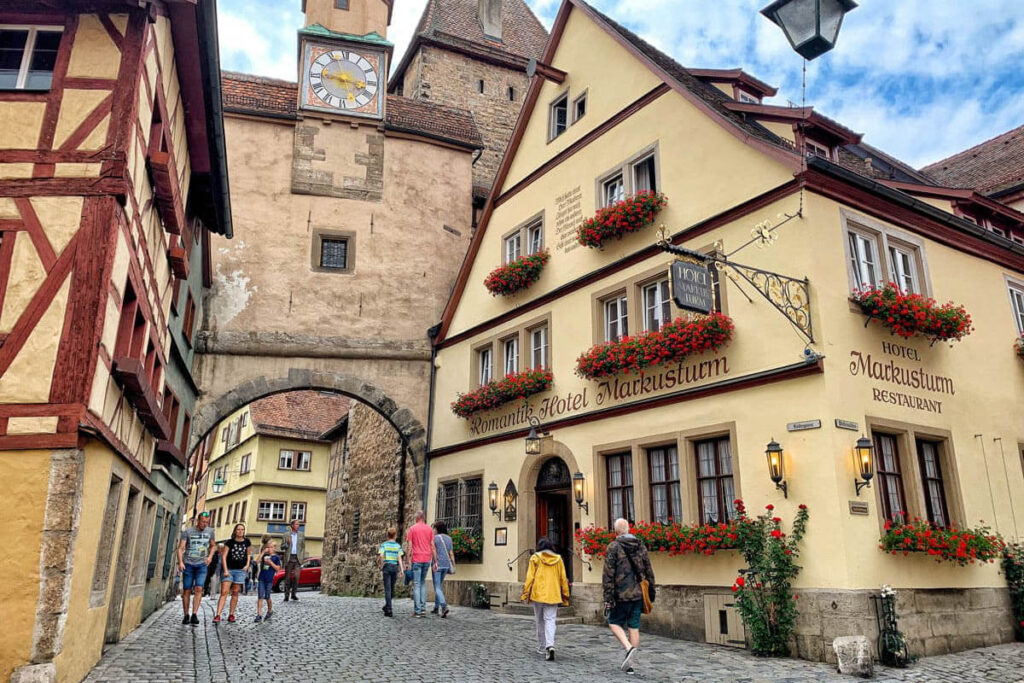
Marktplatz
The Marktplatz is the most famous landmark in Rothenburg ob der Tauber among tourists. Since the early 12th century, it has been the center for selling and buying goods. Over the centuries, beautiful half-timbered houses were built around the square. The square served as a perfect location for meetings, celebrations and other social activities. Today, it is often filled with large groups of tourists, all following a colored flag. Many of these groups don’t venture beyond the first streets near the square, making it easy to escape the crowds.
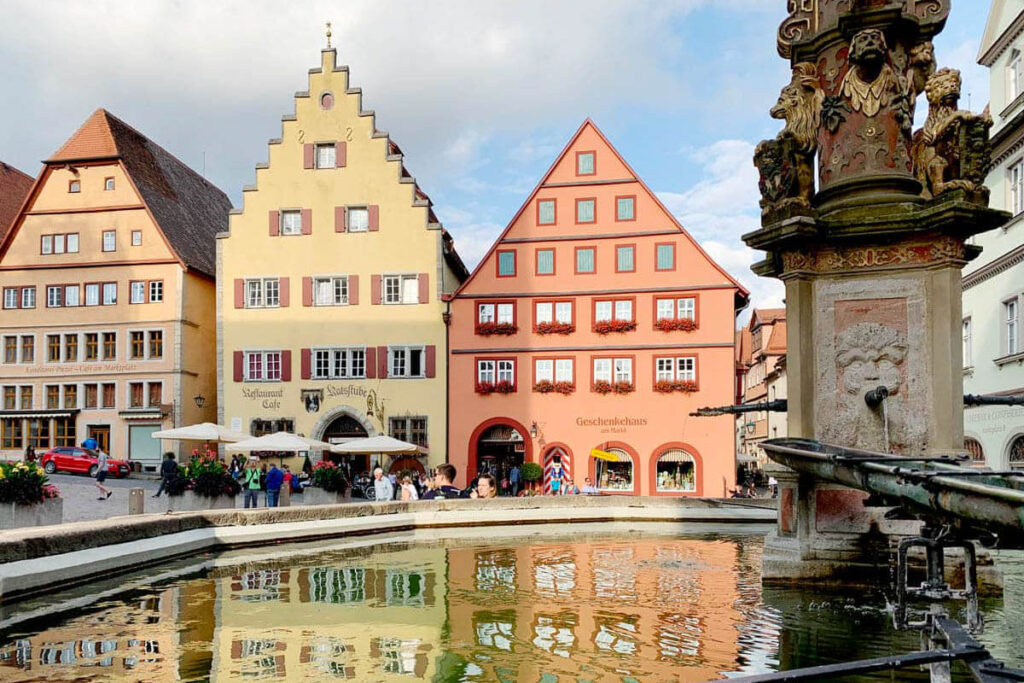
Weißer Turm
The Weißer Turm was also part of the first city wall. However, the tower became most well-known after the Thirty Years’ War, when it served as the starting point for the walk along Galgengasse to the gallows at Würzburger Tor, also known as Galgentor. To clarify the names, a sign shaped like a gallows still marks this area, reminding visitors of those grim days. After World War II, the Weißer Turm was rebuilt following its destruction in the American air raid.
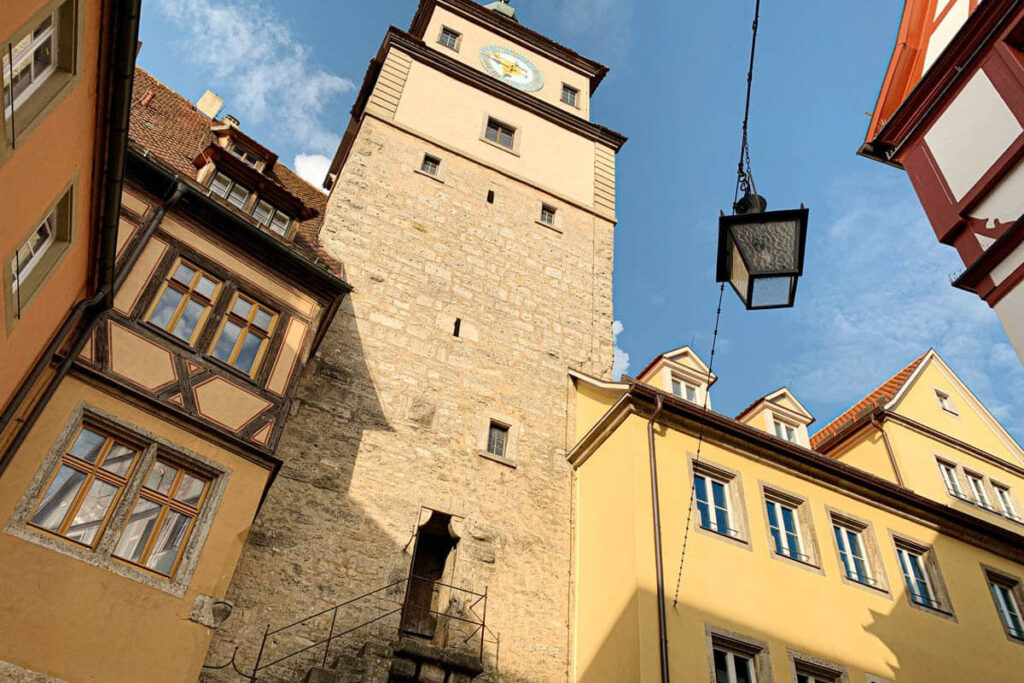
Spitaltor and Spitalbastei
A new gate, Spitaltor, was built in the south of Rothenburg in the late 14th century. The gate was further fortified around 1600 by the Spitalbastei, an eight-shaped bastion. The bastion features two courtyards, seven gates and a drawbridge. It’s an imposing structure that’s definitely worth exploring. If you enter the bastion through the side entrance (under the wooden bridge, see photo below), you can walk all the way around. At the back, you can exit and walk around the bastion on the outside to reach the wooden bridge. It’s a lovely little tour!
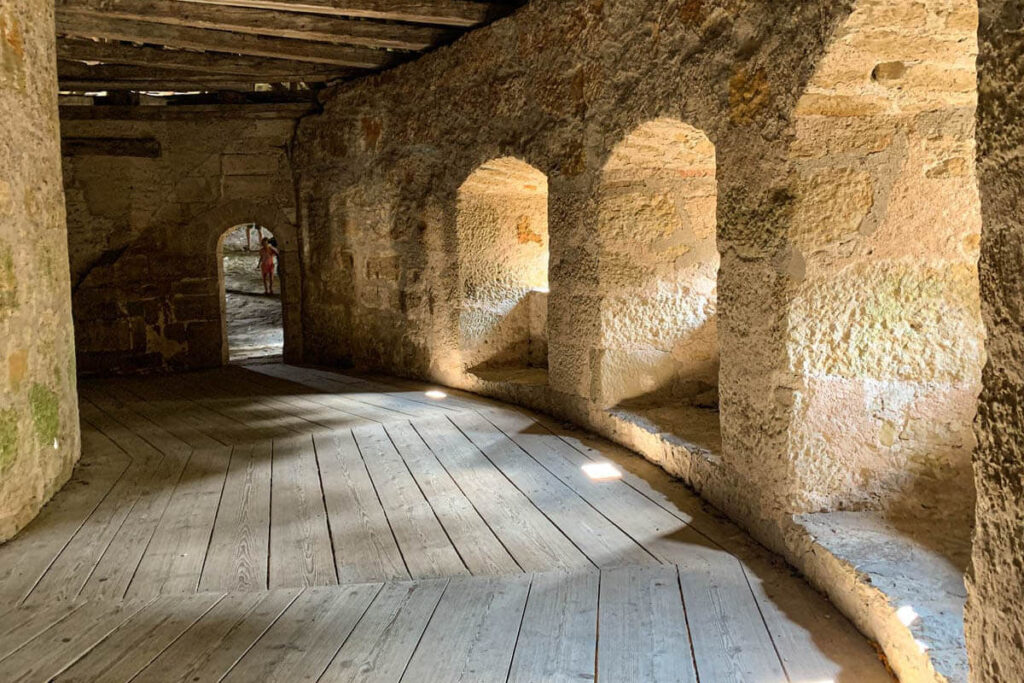
Holzsteg am Spitaltor / Gedeckte Brücke
From the street side, next to the bastion’s main entrance, you can walk toward the covered wooden bridge. The bridge leads to the back of the bastion, where you’ll pass through narrow alleys and stairs behind the gate. If you take the stairs down immediately from the street side, you’ll find yourself under the wooden bridge again, at the side entrance to the bastion. From here, you can walk along the city wall toward the Sauturm, the Stöberleinsturm and the Stöberleinsbühne.
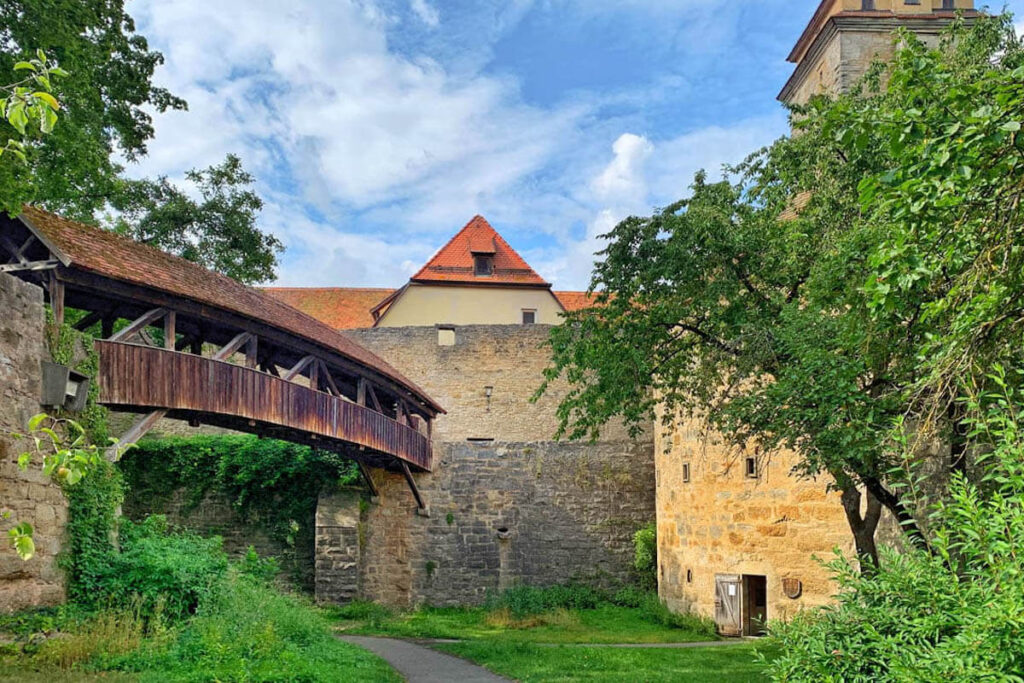
Stöberleinsturm and Stöberleinsbühne
From the Sauturm, you have a nice view of the Stöberleinsturm. To reach this tower, walk along the back of the Reichsstadthalle. According to history, the Stöberleinsturm was originally located outside the town when the walls of Rothenburg ob der Tauber were first constructed and was only later incorporated into the town’s fortifications. Next to the Stöberleinsturm is the Stöberleinsbühne, an open-air theater.
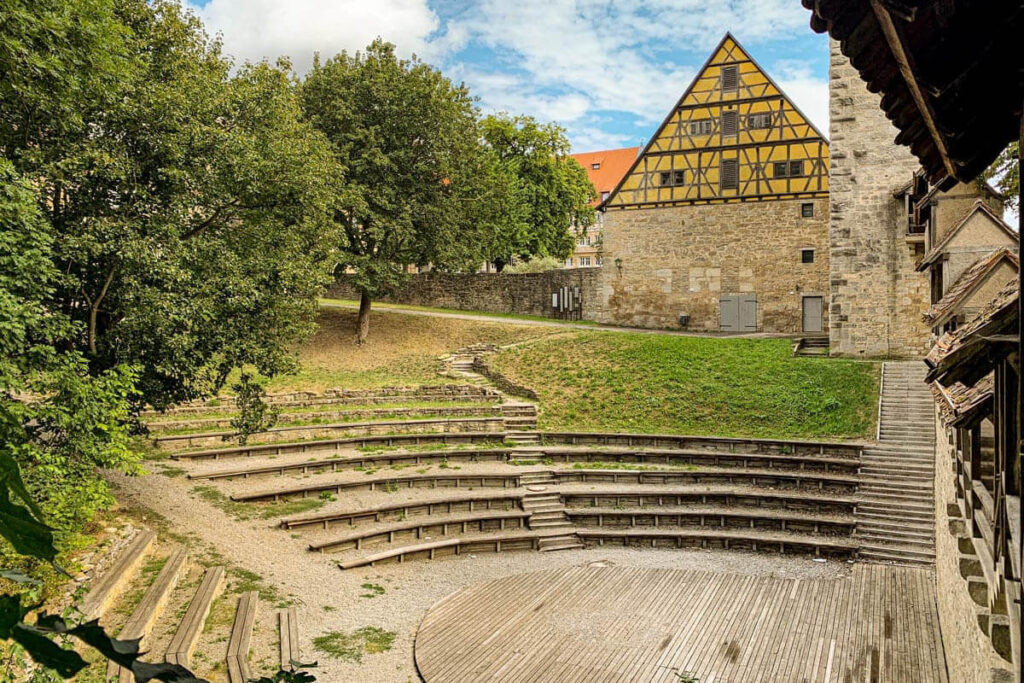
Herrngasse
On Herrngasse stands the oldest stone building in Rothenburg, which houses the Herrnschlösschen Hotel. Herrngasse is truly the patrician street of Rothenburg— a beautiful, wide street lined with colossal, stately half-timbered houses on both sides. The street leads to the Marktplatz, where you’ll find several hotels and charming shops. Notable spots include the famous Weihnachtsmuseum and Käthe Wohlfahrt, the store with the world’s largest collection of traditional German Christmas decorations.
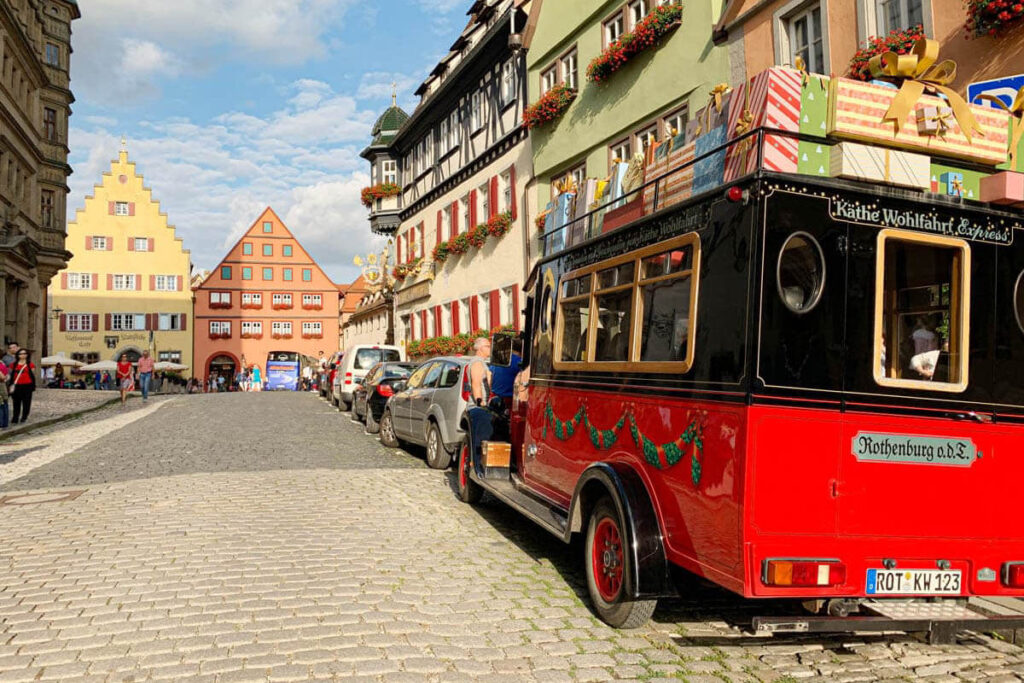
More highlights in Rothenburg ob der Tauber
There are SO many more things to do and see in Rothenburg ob der Tauber. In fact, one day is just not enough. For example, you can take another look at Rothenburgs Burggarten. Here you have a beautiful view of the Tauber Valley and you can see remnants of the Stauferburg, the former castle. The Burgtor, which gives access to the gardens, is also very impressive.
Rothenburger Schneeballen
Above all, do not forget to taste the famous Rothenburger Schneeballen. These sand dough treats have been made in rothenburg ob der Tauber for at least 3 centuries and come in a variety of flavors and sizes. Read more about Rothenburger Schneeballen here. Recommended restaurants in our opinion are Alter Keller and restaurant Roter Hahn.
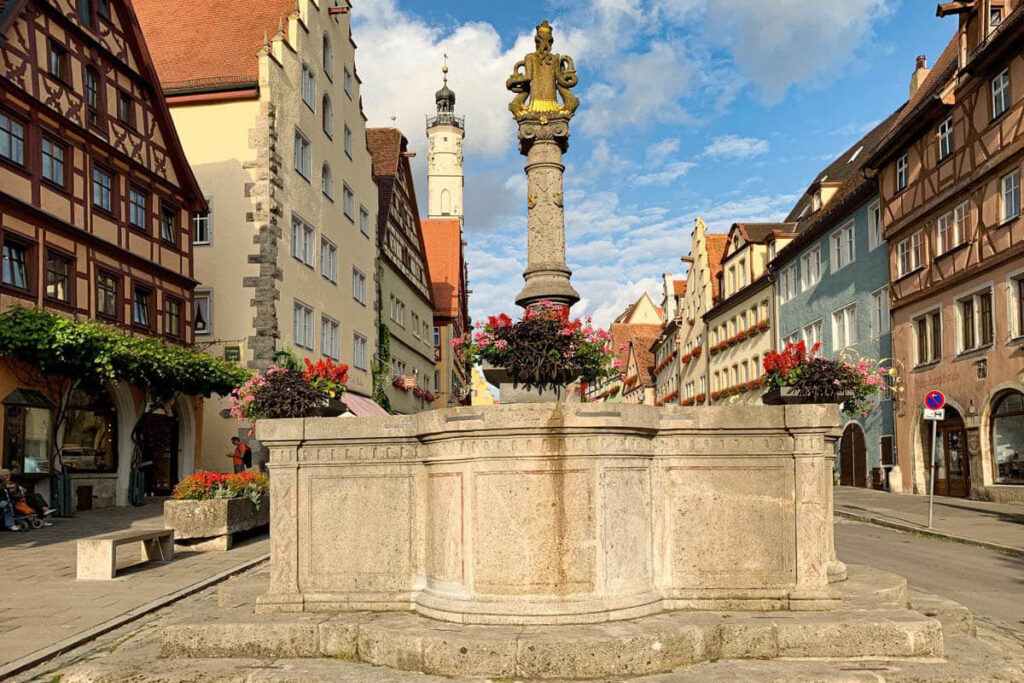
Exploring Rothenburg ob der Tauber with a guide
Prefer a guide to show you around Rothenburg ob der Tauber? You can! A major advantage is that you’ll gain plenty of background information. A guide always has so much more to share, like during a walk through the city’s old town center. You’ll get a completely different perspective of Rothenburg on this 1-hour walking tour with the Night Watchman, who tells dark stories in the evening while lighting lanterns along the streets. Day tours to Rothenburg ob der Tauber are also available from other towns. For example, you can take a day tour from Frankfurt, which includes visits to Rothenburg ob der Tauber and the beautiful city of Heidelberg.
Parking in Rothenburg ob der Tauber
Parking in Rothenburg ob der Tauber can be found at several locations just outside the city walls. We parked at P4 and walked straight through the town wall towards Klingentor. P5 is located right at Klingentor. The advantage of parking here is that you can walk all the way along the city wall to Spitaltor and then wander through the center, passing many of Rothenburg’s sights. At most parking lots outside the town wall, the rate is €1.10 per hour. After 6 p.m., parking is free. Parking inside the town wall generally costs €1.70 per hour, with the same free parking after 6 p.m. (prices as of summer 2023).
